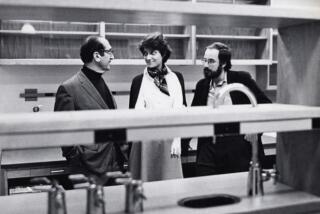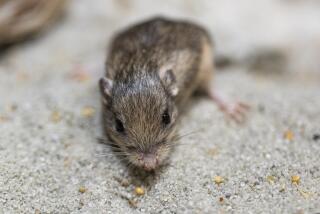The Mouse and Why It Roars on the Research Front
- Share via
Scientists are always writing articles about mice. Reporting on their genes. On how their limbs grow. Plying them with chemicals. Making them run mazes. When the draft of the human genome was finished, the mouse was the next mammal in line to have its genome decoded.
What’s so good about a mouse? If a scientist had forgotten his seminar notes one day last century, could it have been a gerbil that ended up being the focus of all this attention? A hamster? A chinchilla? A rhino? ! Mouse maven Muriel Davisson obligingly agreed to try to answer these questions.
Happenstance, in part, was behind the giddy rise of the mouse in science, says Davisson, a senior staff scientist at Jackson Laboratory in Bar Harbor, Maine. (The Jackson lab is stuffed to the gills with thousands of different breeds of mice--spotty, fat, pink-eyed, short-eared, you name it.)
At the start of the 20th century, a scientist named William Castle decided mice would be just the ticket for testing that newfangled science of genetics. Later, other scientists--such as Clarence Cook Little, founder of Jackson lab, carried on where Castle left off, amassing a slew of mouse information, and discovering all kinds of genetically different mice.
Later, it was only natural that scientists gravitated toward the mouse instead of, say, another little critter, because mice were so well-known. But Castle and Little did choose mice for a reason.
“They’re small, they’re economical, they’re easy to house,” says Davisson. And they are speedy. “In nine weeks you can go from a female getting pregnant to a new male or female,” she says.
Plus, should you be interested in studying old mice, you won’t have to wait around for eons like you would if you were working with a rhino. (Old mice can be really useful; a scientist at USC recently told me he’d employed them to study the effects of aging on saliva flow.) “One year in a mouse is equivalent to about 30 years in a human--so you can have an old, aged mouse in three years,” Davisson says.
Mice are also a lot like us, even if we’re big, clodhopping and short on fur. Our genomes are 85% to 95% identical. Our kidneys, hearts and other facets of our physiology are much the same as those of mice. Our embryos develop much the same way.
And these days, researchers have a plethora of mice tailor-made for studying diseases. Some of the mice have mistakes in the mouse version of genes involved in human diseases; some of the mice are high-tech, designed by modern genetic tricks.
There are “nude” mice, discovered in 1962, which not only lack fur but can’t make important cells of the immune system. Scientists have used them to study human cancers that are grafted onto the mouse. There are mice with genetic constitutions that make them especially aggressive, fat, wrinkly skinned or big-boned. There are mice that lose their fur in patches. There are mice with names like “weaver,” “staggerer” and “reeler,” thus named for their ungainly gaits because they lack cells in a region of the brain involved in balance.
Huntington’s disease, cystic fibrosis, deafness, blindness, congenital heart problems and diabetes--all can be studied in mice, Davisson says. And new possibilities are emerging. The other day we read about a strain that could be useful for studying preeclampsia, a complication of pregnancy.
Davisson’s group has even come up with a mouse made for studying Down syndrome. In humans, the condition--which causes mental retardation, among other things--is due to a single, extra copy of chromosome 21. Her lab managed to create mice that have extra copies of many of the equivalent mouse genes. The mice, too, have problems with learning and memory.
One of the hottest areas, Davisson says, is using mouse strains to study various aspects of behavior. If they could solve the procrastination problem in mice, I, for one, would be eternally grateful.
*
If you have an idea for Booster Shots, write or e-mail Rosie Mestel at the Los Angeles Times, 202 W. 1st St., Los Angeles, CA 90012 or rosie.mestel@latimes.com.






